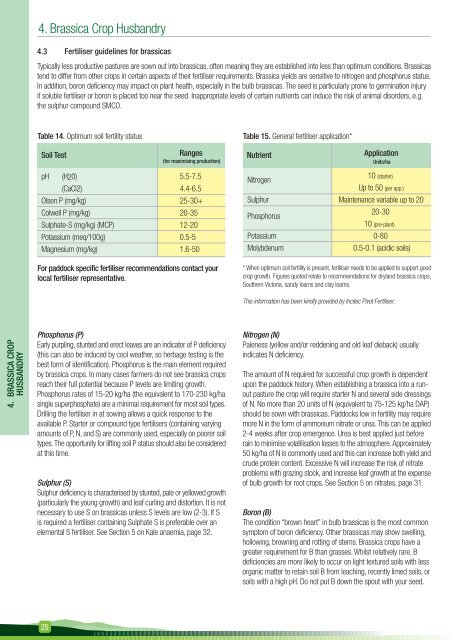Brassica Reference Manual - Agricom
Brassica Reference Manual - Agricom
Brassica Reference Manual - Agricom
Create successful ePaper yourself
Turn your PDF publications into a flip-book with our unique Google optimized e-Paper software.
4. BRASSICA CROP<br />
HUSBANDRY<br />
4. <strong>Brassica</strong> Crop Husbandry<br />
4.3 Fertiliser guidelines for brassicas<br />
Typically less productive pastures are sown out into brassicas, often meaning they are established into less than optimum conditions. <strong>Brassica</strong>s<br />
tend to differ from other crops in certain aspects of their fertiliser requirements. <strong>Brassica</strong> yields are sensitive to nitrogen and phosphorus status.<br />
In addition, boron deficiency may impact on plant health, especially in the bulb brassicas. The seed is particularly prone to germination injury<br />
if soluble fertiliser or boron is placed too near the seed. Inappropriate levels of certain nutrients can induce the risk of animal disorders, e.g.<br />
the sulphur compound SMCO.<br />
Table 14. Optimum soil fertility status<br />
Soil Test<br />
pH (H20) 5.5-7.5<br />
(CaCl2) 4.4-6.5<br />
Olsen P (mg/kg) 25-30+<br />
Colwell P (mg/kg) 20-35<br />
Sulphate-S (mg/kg) (MCP) 12-20<br />
Potassium (meq/100g) 0.5-5<br />
Magnesium (mg/kg) 1.6-50<br />
For paddock specific fertiliser recommendations contact your<br />
local fertiliser representative.<br />
Phosphorus (P)<br />
Early purpling, stunted and erect leaves are an indicator of P deficiency<br />
(this can also be induced by cool weather, so herbage testing is the<br />
best form of identification). Phosphorus is the main element required<br />
by brassica crops. In many cases farmers do not see brassica crops<br />
reach their full potential because P levels are limiting growth.<br />
Phosphorus rates of 15-20 kg/ha (the equivalent to 170-230 kg/ha<br />
single superphosphate) are a minimal requirement for most soil types.<br />
Drilling the fertiliser in at sowing allows a quick response to the<br />
available P. Starter or compound type fertilisers (containing varying<br />
amounts of P, N, and S) are commonly used, especially on poorer soil<br />
types. The opportunity for lifting soil P status should also be considered<br />
at this time.<br />
Sulphur (S)<br />
Sulphur deficiency is characterised by stunted, pale or yellowed growth<br />
(particularly the young growth) and leaf curling and distortion. It is not<br />
necessary to use S on brassicas unless S levels are low (2-3). If S<br />
is required a fertiliser containing Sulphate S is preferable over an<br />
elemental S fertiliser. See Section 5 on Kale anaemia, page 32.<br />
25<br />
Ranges<br />
(for maximising production)<br />
Table 15. General fertiliser application*<br />
Nutrient<br />
Application<br />
Units/ha<br />
10 (starter)<br />
Nitrogen<br />
Sulphur<br />
Up to 50 (per app.)<br />
Maintenance variable up to 20<br />
Phosphorus<br />
20-30<br />
10 (pre-plant)<br />
Potassium 0-80<br />
Molybdenum 0.5-0.1 (acidic soils)<br />
* When optimum soil fertility is present, fertiliser needs to be applied to support good<br />
crop growth. Figures quoted relate to recommendations for dryland brassica crops,<br />
Southern Victoria, sandy loams and clay loams.<br />
This information has been kindly provided by Incitec Pivot Fertiliser.<br />
Nitrogen (N)<br />
Paleness (yellow and/or reddening and old leaf dieback) usually<br />
indicates N deficiency.<br />
The amount of N required for successful crop growth is dependent<br />
upon the paddock history. When establishing a brassica into a runout<br />
pasture the crop will require starter N and several side dressings<br />
of N. No more than 20 units of N (equivalent to 75-125 kg/ha DAP)<br />
should be sown with brassicas. Paddocks low in fertility may require<br />
more N in the form of ammonium nitrate or urea. This can be applied<br />
2-4 weeks after crop emergence. Urea is best applied just before<br />
rain to minimise volatilisation losses to the atmosphere. Approximately<br />
50 kg/ha of N is commonly used and this can increase both yield and<br />
crude protein content. Excessive N will increase the risk of nitrate<br />
problems with grazing stock, and increase leaf growth at the expense<br />
of bulb growth for root crops. See Section 5 on nitrates, page 31.<br />
Boron (B)<br />
The condition “brown heart” in bulb brassicas is the most common<br />
symptom of boron deficiency. Other brassicas may show swelling,<br />
hollowing, browning and rotting of stems. <strong>Brassica</strong> crops have a<br />
greater requirement for B than grasses. Whilst relatively rare, B<br />
deficiencies are more likely to occur on light textured soils with less<br />
organic matter to retain soil B from leaching, recently limed soils, or<br />
soils with a high pH. Do not put B down the spout with your seed.


